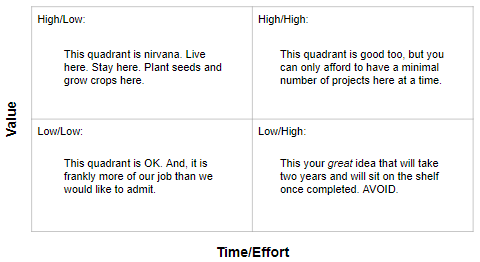The Implementation of People Analytics

“There is no correlation between effort and impact of people analytics projects.” How do you find the right strategy for burgeoning people analytics teams?
When discussing the field of people analytics, I often find myself most intrigued with the application considerations of the work, rather than the data analysis itself. That’s why I chose to read an article by Cole Napper entitled, “You’re leading People Analytics: Now what? | Strategy & Implementation”. It is part of a series that explores the different aspects of leading a people analytics team.
I appreciated the practicality of this article in particular, because it addresses how you can gain organizational buy in if you’re building a new people analytics team. The advice provided felt actionable, and related to a lot of the topics discussed in class. For instance, two strategic pitfalls were identified that often occur when starting a new people analytics team:
1) trying to do too much advanced analysis with only the bad data easily available to you
2) only focusing your efforts on improving your data foundations for an extended period of time before delivering any value
This balance seems critical to gaining organizational buy-in. Offering false insights via analysis using poor quality data (garbage in, garbage out) is a surefire way to lose credibility, while being too heads down in the science without showing the real application of the work in a timely manner will cast doubt on the usefulness of people analytics.
As someone just learning about people analytics, I find this to be an intimidating challenge. How do you know when your analysis is “enough”? During seemingly every case discussion we come up with a large series of continued questions about the analysis being reviewed. This feels even harder to determine when a misguided or incorrect recommendation due to incomplete analysis has the potential to derail your team’s credibility.
Aside from the execution strategy within projects, the article also addresses what to think about when actually selecting projects (see below). Picking projects across the spectrum of time and value is going to be most important when starting a people analytics practice from scratch. I think the goal of any new team would be to be within the top right quadrant, but in most cases it likely takes time to gain organizational support and be able to take on those sorts of projects. The real danger probably lies in the bottom right quadrant. This idea exists in user experience as well. Oftentimes a designer can get really excited about an interface and go off on a tangent designing something really beautiful or “cool,” but it is not aligned with the needs of users. I could see a similar risk here, where data scientists potentially become enamored with something they could do, rather than focusing on the value side of the equation.

I think many of the challenges described above stem from the fact that people analytics is an internally facing function. Due to this, there is typically less direct impact on the business outcomes. Oftentimes, the affects are indirect, and are a step or two removed. For example, maybe a people analytics project doesn’t directly lead to higher customer retention, but it leads to higher employee retention, which in turn leads to better service and, therefore, higher customer retention. Connecting those dots and making the full spectrum of outcomes provided clear to leadership and the organization as a whole appears to be an integral component of building a people analytics practice.



I appreciated this article because it reinforces the foundation of starting with good data and baselines. I appreciated your insight about internally facing because there is research that internal reflections (at least with pedagogy) help reinforce and uncover the values, goals, and critical functions/motivations that help connect you from point A to point B. I’m stealing the Value and Time/Effort table for personal use. – Camlinh To
Nice summary of the article first followed by your thoughts.
Like we’ve discussed in some of our classes, I think especially initially it’s best to work with some of the stakeholders and people closest to data production (top, bottom, and everyone in the middle) at every step of the process (ideation, data collection, analysis, interpretation), so they see with transparency what you’re doing and are invested in the result. As different departments gain experience with the people analytics team, you start to gain their trust and interest, and you gain confidence in the team as well, then you can start to a little more independently.
You made a great point in the last paragraph. It can often be harder to point to specific gains or usefulness. If you have a few good experiences with different departments, they may voluntarily champion your value to the higher ups.
I appreciate your article and totally agree with your statement that “I often find myself most intrigued with the application considerations of the work”.
I believe that the starting point is to identify and clarify what unresolved management or business issue we need to solve. If people analytics can be useful given available use cases, we should experiment with it. Needless to say, people analytics is one of the tools that may potentially solve unresolved management issues.
Moreover, as you mentioned direct/indirect impact in the last paragraph, management issues are complex as a result of a series of chains of observed/unobserved causes, and identifying a key cause is critical. Therefore, if we can reveal it by using people analytics, it will have long-lasting impact.